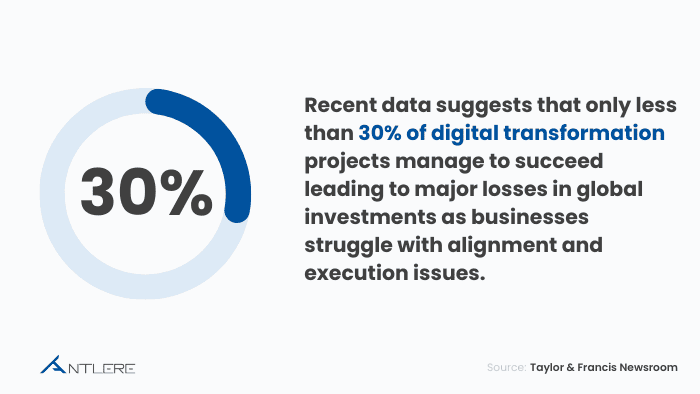
Customer Experience Transformation: Strategies for Success in a Digital World
The new era of digital is challenging companies to upgrade their business strategy and adapt to the evolving marketspace. What’s intriguing is -that this change is primarily brought on by the customer rather than companies
That’s interesting about this is that it’s not the companies that are driving this change.
Instead, this change is being driven by the customer.
Today, customers expect relevant content in relation to what they’re doing anytime, anywhere and in the format and on the device of their choosing. It’s their journey that dictates your strategy.
And to keep up with this new kind of “always-connected” customer, your business must embrace technology to deliver an unmatched customer experience.
Fortunately, putting the customer first is already at the center of many organizations’ strategies.
Research shows that 35% of business executives claim that digital transformation helps them to better meet customer expectations and improve operational efficiency (40%), and 38% of executives plan to invest more in technology to make it their competitive advantage.
Let’s explore what customer experience transformation is before we dig into the strategies as to how you can leverage data and technology to deliver an optimal customer experience.
What is Digital Customer Experience Transformation?
Digital transformation can look different for different companies, which makes it tricky to give one definition. However, in broad terms, digital customer experience transformation refers to the integration of digital technology in all aspects of a company – creating foundational changes to how it operates and offers value to its customers.
It’s about transforming the way a company interacts with its customers and providing them with a consistently satisfying experience. Businesses that are keeping up with digital transformation create better engaged customers.
Nike, for example, invests in customer experience transformation with Nike Direct strategy – a direct-to-consumer platform backed by data insights. This has allowed Nike to tailor customer experiences, drive e-commerce growth, and boost engagement – proving crucial to sustaining business through the pandemic.
Digital customer experience transformation creates a portal for businesses to understand a modern, digitally conscious customer, engage with them effectively, and meet their evolved expectations with an omnichannel customer experience.
Recent data suggests that only less than 30% of digital transformation projects manage to succeed – leading to major losses in global investments as businesses struggle with alignment and execution issues. Taylor & Francis Newsroom , SAP News Center

So, why don’t all customer experience transformation efforts succeed?
Let’s look at some strategies that can help you optimize digital transformation.
Establish a Clear Strategy Before Embarking on Digital Transformation and Customer Experience Optimization
Innovations and technologies are rapidly evolving – demanding businesses to catch up to the fast pace. Even successful businesses get shaken up a little advancing digitalization. We all know how Uber, back in 2009, revolutionized the taxi industry by enabling people to catch a ride using a mobile app. If we look at recent examples,
Elon Musk and Google have been competing to launch self-driving cars – transforming the customer experience. With new ideas and concepts constantly being introduced in the industry, businesses need an effective long-term strategy to survive and thrive in the modern digital landscape.
In a 2023 survey, McKinsey reported that businesses investing in digital transformation are 1.5 times more likely to experience double-digit revenue growth compared to their competitors. (McKinsey & Company)

This is why you need an effective customer experience transformation strategy to optimize your business growth and long-term success.
Some essential questions to ask for digital transformation customer experience:
- Where does your business stand today?
- Where do you see your business in the future?
- What can you do to get where you want to be?
Businesses need a plan that highlights which technologies ought to be adapted and how they offer protection against digital disruption. Thats why it’s crucial to study your core processes and systems to dig opportunities where you can use digital transformation.
Reshape The Customer Journey
With customers having a higher autonomy as to how they want their services, it’s important that you create novel experiences to match their evolved expectations. According to a Harvard Business Review survey, 40% of participants said that customer experience is their foremost priority when it comes to customer service transformation. As every customer experience affects your brand perception as a whole, it has become imperative to prioritize investing in positive customer relations.
Set Up a Flexible and Agile IT Environment
A basic digital setup won’t be able to suffice in the current competitive landscape. What you need is an adaptable IT infrastructure that can fulfill your growing business needs and customer expectations. You need to implement agile systems to optimize your customer experience strategies – making sure they are responsive to industry shifts and are empowered to fulfill your clients’ demands.
With features like omnichannel capabilities and AI-driven automation, your company can develop an adaptive and impactful IT environment. Having a digitally advanced experience management system will help you minimize any operational bottlenecks and create a smooth workflow – optimizing your CX transformation.
Personalize Your Customer Experience
Today’s customers expect businesses to cater to their unique wants and preferences. Data from Accenture suggests that 75% of buyers are more likely to purchase from a brand that knows their name, their purchase history, suggests products/services based on their purchase history.
The great thing is that customers are now comfortable with companies using their data to elevate their experience. However, to capitalize on this opportunity, you need to invest in a CXM platform. Without evaluating your customers as individuals, you won’t be able to provide them with a customized and unique experience.
That brings us to the final growth factor when it comes to customer experience transformation – an omnichannel customer experience.

A Seamless Omnichannel Experience
With technology, your customers can get whatever they want, whenever they want, and the way they want it. Your customers expect prompt responses which require companies to maintain 24/7 accessibility throughout the week.
With everything happening in real time, businesses need to offler optimal accessibility, customization, and immediacy to customers that caters to their needs in the long run. A single channel is not effective at managing all customer interactions. You need seamless multichannel support for optimal CX digital transformation.
Conclusion
In the fast-evolving digital landscape and digitally connected world, businesses are required to implement an effective customer experience transformation strategy. With digital transformation companies can better engage modern-day empowered customers.
From developing a robust strategy to investing in an omnichannel approach, the path to transforming the customer experience is paved with understanding and prioritizing the customer journey.
Ready to boost your customer experience?
Explore how Antlere can help you harness the power of digital transformation to create meaningful customer interactions and drive your business forward.

Frequently asked questions
What are some common roadblocks to digital transformation, and how can you overcome them?
Some common roadblocks include:
- Resistance to change within the company
- Financial constraints
- Lack of digital expertise
These can be overcome with small tasks to reinforce their significance with ROI and quick wins. Also, recruiting digital expertise and training programs can manage skill gaps.
Why is feedback important in digital customer transformation?
Customer feedback offers a great deal of insight into customer preferences and needs – enabling businesses to adapt new strategies and elevate their overall experience.
How can small businesses use digital transformation?
Small businesses can begin by highlighting areas that need improvement – focusing on fostering solid customer relationships and investing in scalable technology solutions.
What technologies are crucial for efficient customer experience transformation?
Some useful technologies include:
- Customer experience management (CXM) solutions
- CRM systems
- Omnichannel communication platforms
- AI-driven analytics
How can companies measure the success of their customer experience transformation investments?
Success of customer experience transformation efforts can be measures using:
- Net Promoter Score (NPS)
- Customer Satisfaction Score (CSAT)
- Customer retention rates
- Overall sales growth


